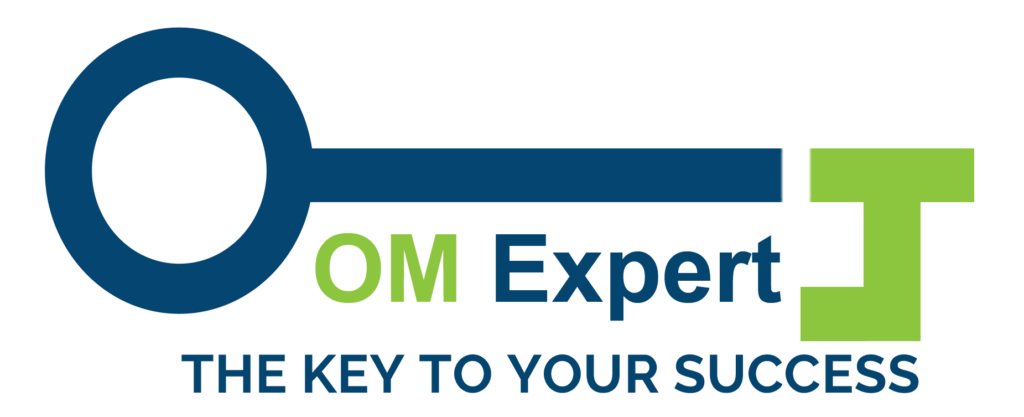Digital Asset Management - Safely Managing Your Assets in the Age of AI
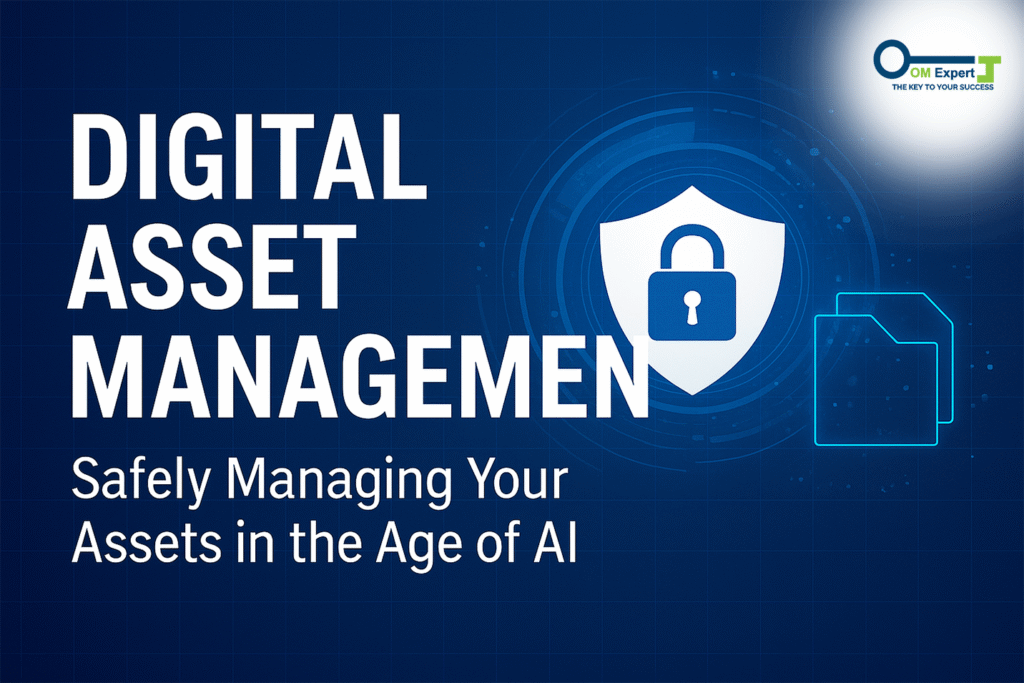
Digital life has expanded so much in the last decade that almost every part of our personal and professional work now depends on online files, data, and systems. Everything has turned digital, from photos and documents to crypto investments and creative assets. The need for managing and protecting these resources with care became a strong one. It is for this reason that Digital Asset Management has become among the most important systems for individuals, businesses, creators, and organizations of all sizes. The rise of artificial intelligence has added more speed to this shift. Artificial intelligence tools can create content, organize information, and analyze huge sets of data within seconds.
While this has made work a lot easier, it has also raised new security concerns. In this modern environment, the value of digital assets has gone up, and so have the risks. This means that a strong and secure foundation is required for handling every file, every investment, every creative piece, and every business document. Digital assets today go far beyond just simple files. They involve financial records, access keys, online accounts, crypto tokens, creative work, confidential plans, and everything that lives on your device or in the cloud.
What are digital assets?
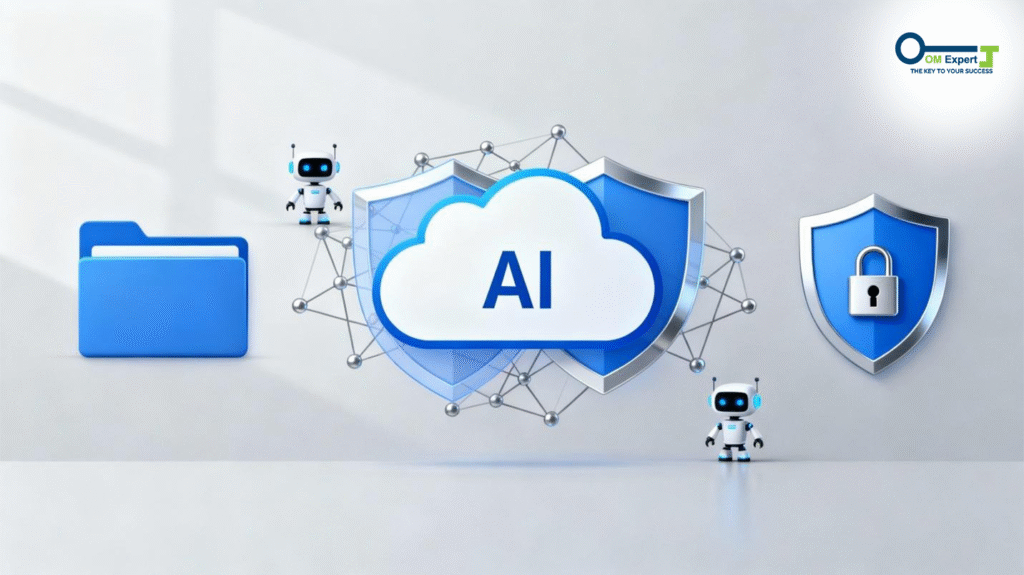
Anything that has value and exists in electronic form can be termed a digital asset. It includes images, audio, videos, design files, product photos, documents, spreadsheets, presentations, marketing media, system backups, crypto tokens and NFTs, access credentials, and more. Even social media content, brand guidelines, ads, and creative campaigns qualify as digital assets. Since everything is now created, stored, and shared online, the scope of digital assets keeps increasing with each passing year.
Importance of DAM in the AI Era
Artificial intelligence has changed the way digital content is handled. AI-powered tools today help in content creation, file management, and data analysis. But at the same time, AI has ushered in new cybersecurity challenges. The proliferation of fake content, manipulated visuals, algorithmic misuse, and automated attacks has increased. This makes the digital asset executive so crucial in this AI era: it provides for organized storage, better tracking, and a contained environment for sensitive files.
How AI Impacts Digital Asset Security
AI impacts digital asset security in several ways. The plus side of AI helps in the detection of unusual behavior, alerts users to threats, enhances file classification, and automates protection. On the minus side, AI may break weak systems, extract data, generate deepfakes, or misuse information. This dual nature of AI depicts why, more than ever, Digital Asset Management systems need stronger protocols, smarter monitoring, and better governance.
Core Components of Digital Asset Executive
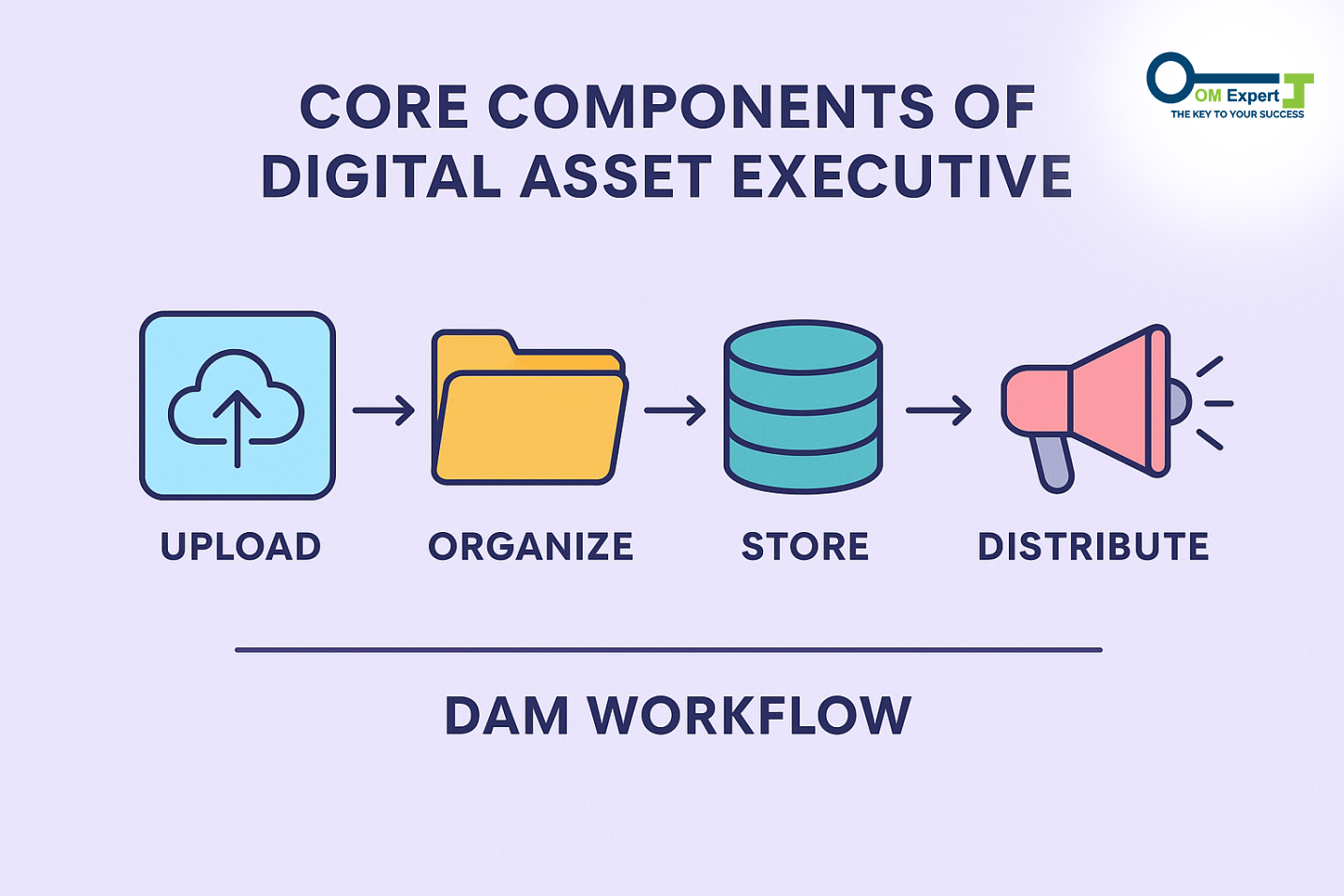
Today’s businesses and individuals handle more digital files than ever, and the volume is still growing every day. It is, therefore, of extreme importance to understand what the pillars are that support effective Digital Asset Management. A sound DAM foundation creates clarity and eliminates confusion, reduces file duplication, and makes sure that every asset can be traced, accessed, and used at the right time.
These features not only boost productivity but also enhance security, especially in the fast-paced digital environment where data travels across teams, devices, and cloud platforms. A well-structured DAM system supplants scattered file storage with a uniform, organized, and reliable process that makes daily operations more efficient.
Centralized Storage & Repository
A central repository is the basis of every DAM system. Instead of having the digital assets scattered across devices, drives, mobile phones, personal cloud accounts, and email attachments, centralized storage keeps everything in one organized place. This structure reduces the chances of losing files, increases security, and makes it easier to track who is using what.
Metadata, Tagging & Organization
Metadata refers to information attached to a file that provides context as to what is contained. Tagging, labeling, and classification allow users to find, sort, and retrieve files fast. When a DAM system uses strong organizational standards, the entire workflow becomes smoother, especially for teams handling a great amount of content.
Access Control & User Permissions
One of the biggest strengths of DAM systems is managing who can open, edit, download, or share a file. Access control ensures sensitive information remains protected. User permissions build structured roles so only the right individuals can access important data, avoiding accidental leaks and preventing unauthorized changes that may harm security.
Workflow Automation & Version Management
Teams often work on different versions of the same file. Without a system, these duplicate versions are confusing. DAM manages proper version control so that users are always aware of which is the most current file. Workflow automation also improves efficiency in assigning tasks, triggering approvals, and managing updates automatically. This creates an entirely streamlined system within Digital Management.
Role of AI in Digital Asset Management
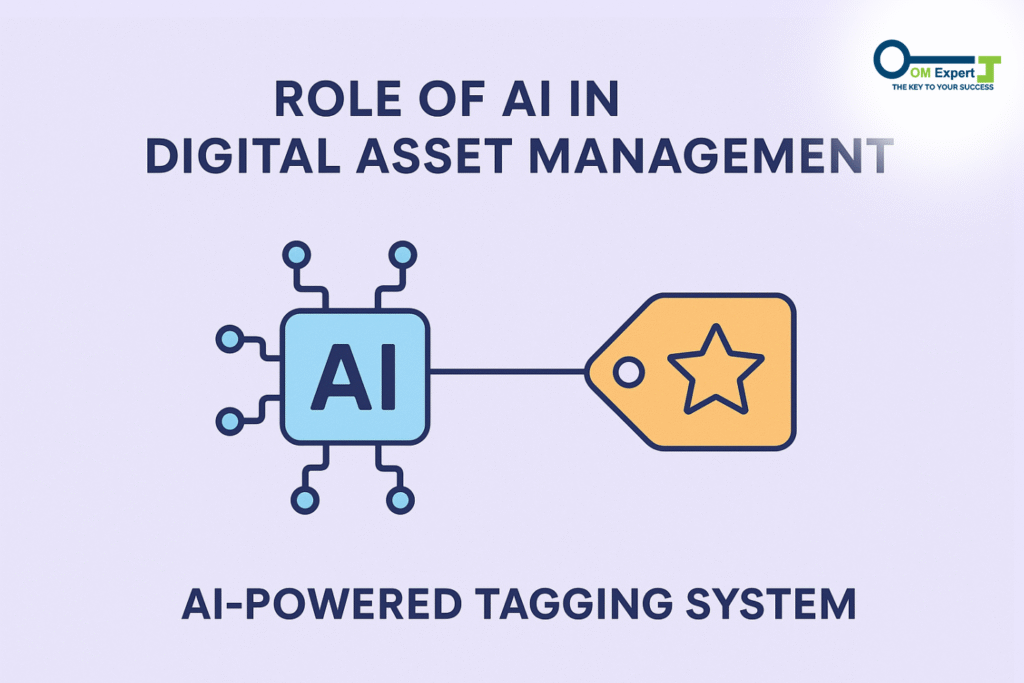
AI has now become one of the most influential forces in molding digital systems today. Its role in Digital Asset Management is expanding fast because AI is capable of processing big volumes of data way faster than traditional methods. AI-driven DAM systems understand content, predict user needs, suggest accurate classifications, and find hidden patterns that humans may overlook.
As different sectors embrace AI, it is changing how people store, use, and protect digital assets. AI makes DAM faster, smarter, and more intuitive, enabling teams to handle thousands of files with less effort. Meanwhile, AI is presenting new challenges that require careful planning. Understanding the capabilities and limitations of AI can create a balanced strategy in DAM, using automation at the right places while maintaining strong human oversight.
AI-POWERED TAGGING & SMART SEARCH
AI can analyze the contents of a file and automatically generate tags, descriptions, and categories. This reduces manual work and increases accuracy. Smart search makes it possible for users to surface files based on keywords, objects in images, audio content, or even visual patterns. That is a major upgrade in Digital Asset Executive, accelerating entire workflows.
Duplicate Detection & Auto-Classification
AI systems identify duplicate files and get rid of extra copies. This clears up storage and prevents confusion. Automatic classification helps manage enormous libraries of assets by grouping them logically. For companies with thousands of files, this automation is a major benefit of modern Digital Asset Management.
AI for Content Rights and Usage Insights
AI keeps track of usage, rights adherence, and misuse of media content. This provides further insights into user behavior, performance, and reach in the digital realm. These insights add value to a content strategy and ensure legality within Digital Asset Executive.
Risks of AI in DAM – Deepfakes, Data Misuse
AI is powerful, but it also introduces risk. Deepfakes can manipulate images or videos. Data misuse can occur when AI systems are not monitored. Weak systems can be exploited, which results in the loss of important assets. Due to these associated risks, strong governance becomes an integral part of Digital Asset Management in today’s environments.
How to Implement a Secure DAM Strategy
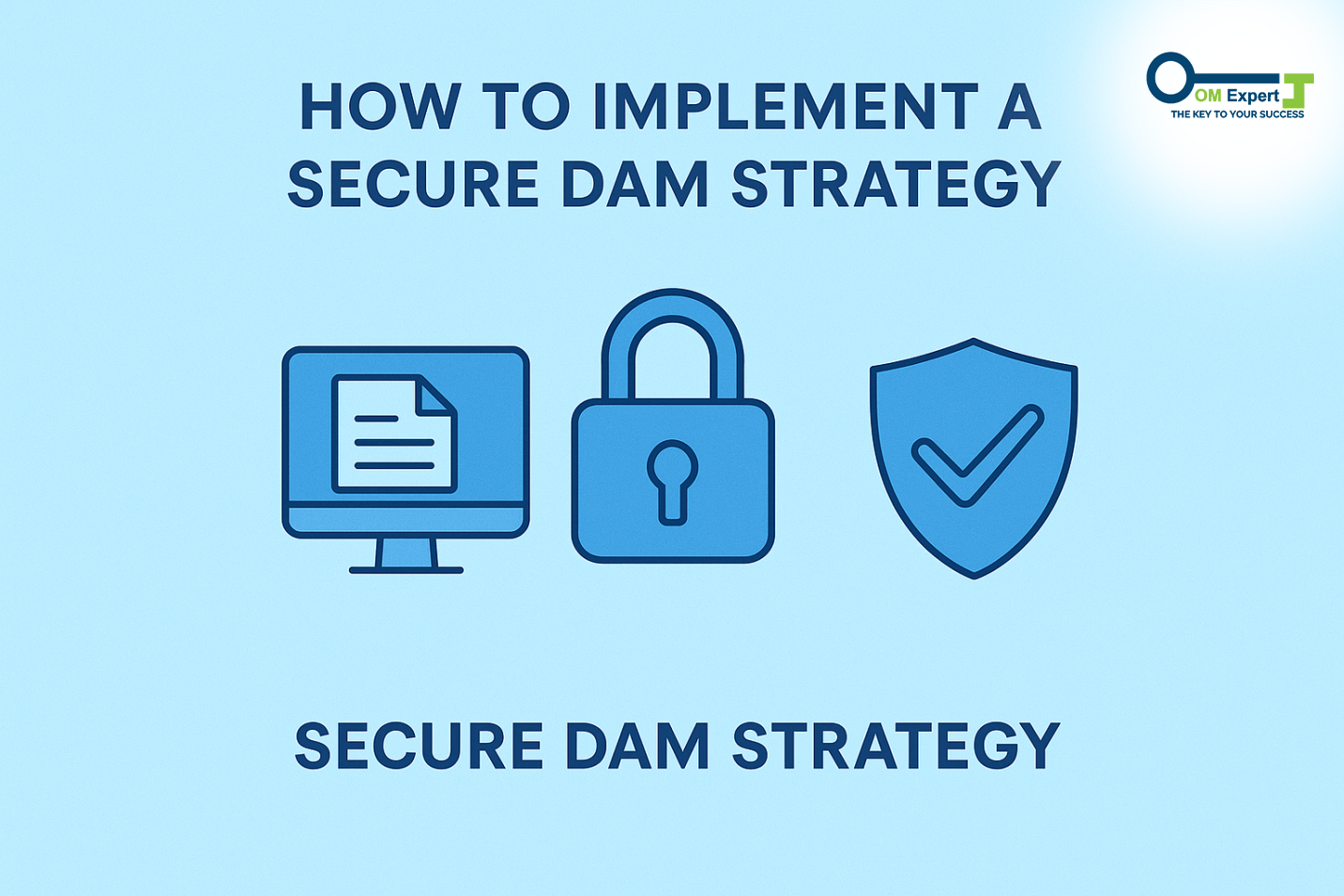
A secure DAM strategy is not built overnight; it takes structured planning, careful evaluation, and consistent improvement. Digital Management is truly effective only when every part of the system, from asset identification to long-term monitoring, works together. In general, implementing a secure strategy means understanding which assets matter most, which need access, how files move across teams, and what technology will keep them safe.
A strong DAM strategy protects your files from both internal errors and external threats. In addition, it assures you of knowing that all your digital assets are organized, traceable, and safe at all times. When security, workflows, and team practices start to align, DAM will then be a strong backbone that will support business continuity and digital growth.
Asset Audit & Categorization
First, consider all of your digital assets and determine which of these assets are critical. Then group assets by purpose, sensitivity, and usage. Categorization will assist in determining how each asset should be protected inside a Digital Asset Management system.
Choosing the Right DAM Platform
Different platforms offer different features. Some are for enterprise-wide use, while others support a small group of people. Key features to look for include automation, smart search, strong security, and easy access controls. A correct choice of platform will dictate how well one’s Digital Management functions.
Setting Security Protocols: MFA, Encryption
Multi-factor authentication, encryption, secure passwords, and controlled logins are all part of digital assets protection. These security layers reduce unauthorized access. Encryption protects data at rest and in motion, making Digital Management more secure across devices.
Team Training & Permission Policies
Teams need to be trained on how to use DAM correctly. Even the most advanced system will fail if not trained. Clearly define permission rules, show how to store the files, and define who can access what. This assures smooth teamwork inside the Digital Asset Management environment.
Continuous Monitoring & Compliance
Digital threats are constantly changing. Continuous monitoring enables the detection of abnormal behavior; thus, it helps to prevent data breaches. Compliance ensures the compliance of your Digital Asset Management with all legal requirements and industrial standards. Regular audits create a safe environment for long-term digital operations.
Best DAM Tools and Future Trends

The landscape of Digital Asset Management changes fast, and the number of new tools and technologies coming out is growing continuously. The best DAM systems today combine ease of use, automation, scalability, and strong security features to support modern digital workflows. Whether it’s for marketers, designers, media producers, or corporate teams, DAM tools make operations easier and ensure that digital content is accessible where and when it’s needed.
Meanwhile, the future of DAM is in the direction of smarter and more intuitive systems that are driven by AI and blockchain. These innovations warrant deeper insights, stronger ownership protection, and real-time decision-making to shape the next generation in asset management. Understanding today’s tools and emerging trends helps you prepare for a digital-first future where speed, accuracy, and security matter more than ever.
Top Tools – Bynder, Brandfolder, Adobe AEM, Cloudinary
Many of these platforms come with structured storage, AI integration, version control, automation, and increased security. Bynder, Brandfolder, Adobe AEM, and Cloudinary are some of the well-adopted tools in the industry. Such platforms enhance collaboration, speed up workflows, and introduce advanced controls that help strengthen digital asset executives across industries.
Industry Applications (Marketing, E-commerce, Media, Healthcare)
Marketing teams use DAM to manage campaign assets. E-commerce businesses use it for product photos and descriptions. Media companies use it for video files and content rights. Healthcare facilities use DAM to secure patient reports and medical data. Since every industry is driven by digital content today, Digital Asset Management has turned out to be a universal need.
Future Trends – Blockchain, Autonomous AI, Real Time Governance
The future of DAM is blockchain verification, autonomous AI systems, live monitoring, and instant alerts. Blockchain adds transparency and trust. Autonomous AI improves classification. Real-time governance ensures instant decision-making. These will redefine Digital Asset Management in the years to come and create stronger digital ecosystems around the world.
Conclusion
In the era of AI, automation, cloud systems, and digital transformation, managing and protecting your digital assets becomes even more important. A robust Digital Asset Management strategy provides you with clarity, structure, and security for long-term control over your digital life. It protects your identity, preserves your creative work, secures your investments, and keeps your information accessible and organized.
Whether you handle business content, personal data, creative assets, crypto holdings, or online accounts, DAM helps you stay prepared and safe. In today’s landscape, where the threats of digital security are constantly changing, the demand for organized asset management is steadily on the rise. Anyone can build a long-lasting, secure digital ecosystem with the right tools, together with strong policies and proper training. For trusted insights and expert guidance on Asset in Digital Management, look to OM Expert.
